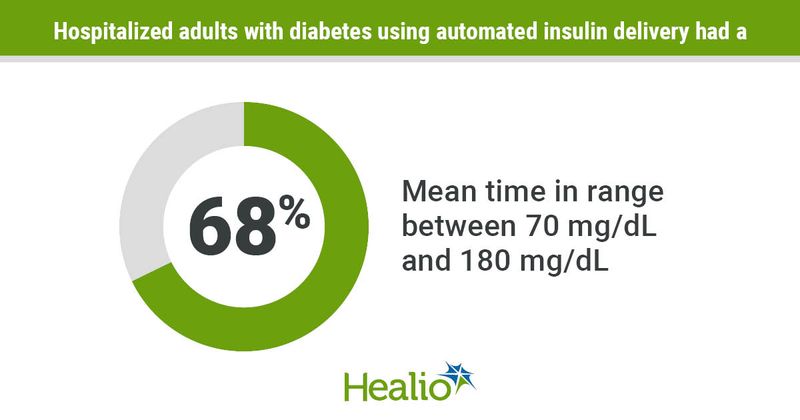Automated insulin delivery may be feasible for hospitalized adults with diabetes
Key takeaways:
- Hospitalized adults with diabetes who used automated insulin delivery had a mean 68% time in range.
- There were no instances of DKA or severe hypoglycemia during the study.
Automated insulin delivery with remote real-time continuous glucose monitoring may be feasible for managing glucose among hospitalized adults with diabetes, according to findings from a small study.
In a single-arm trial published in Diabetes Technology & Therapeutics, health care providers used the Omnipod 5 automated insulin delivery system with a Dexcom G6 CGM to manage glucose for up to 10 days in 18 hospitalized adults with diabetes. The study group had a mean time in range of 68% during hospitalization and the participants spent a median 95% of the time in automated insulin delivery mode.

“The present study suggests incorporating automated insulin delivery with remote operability and components that are physically compatible with the inpatient environment to real-time remote CGM is feasible and has the potential to enhance glycemic control in hospitals, with minimal risk of hypoglycemia,” Francisco Pasquel, MD, MPH, associate professor of endocrinology at Emory University School of Medicine and medical director of endocrinology at Grady Health System, and colleagues wrote.
Researchers enrolled adults aged 18 years or older with type 1 or type 2 diabetes who required insulin therapy during a general hospitalization to participate in the trial at Emory University, Stanford University and the University of Virginia. Study investigators and trained nurses used the automated insulin delivery system and CGM to manage glucose in each participant until discharge or for a maximum of 10 days. CGM accuracy was assessed by comparing data with capillary blood glucose values. Medication use, hematocrit and creatinine levels, CGM data and insulin delivery data were collected. Hospitalized adults completed a questionnaire at the end of the study to assess their perceptions of the device. The primary endpoints were time spent in automated insulin delivery and time in range with a glucose level between 70 mg/dL and 180 mg/dL.
There were 18 adults who completed the study from June 29, 2021, to Aug. 8, 2022. Of the participants, 16 had 48 hours or more of active CGM data and were included in glycemic analyses.
The study group spent a median 95% of time in automated insulin delivery mode. The mean time in range was 68%. Mean time with glucose of less than 54 mg/dL was 0.06%, mean time with glucose between 54 mg/dL and 69 mg/dL was 0.17%, mean time with glucose between 181 mg/dL and 250 mg/dL was 25%, and the mean time with a glycemic level of more than 250 mg/dL was 6.9%. Participants had a mean glucose of 167 mg/dL. The mean daily basal insulin delivery was 0.21 U/kg per day, and the mean total daily insulin dose was 0.41 U/kg per day. Adults spent a median 20% of their time with insulin suspended. There were no reports of diabetic ketoacidosis or severe hypoglycemia.
There were 16 adults who completed the questionnaire at the end of the study. Of the respondents, all of them said they liked using automated insulin delivery for glycemic management in the hospital, and 94% said they wanted to use the system at home. Thirty-eight percent of participants said using finger sticks to validate CGM values was burdensome and 19% preferred to use only the CGM.
The researchers noted there were a few limitations, including the small size of the study population, the single-arm design and that the efforts made by the study investigators and nurses in managing the participants’ glucose may not be scalable in a real-world setting.
“Further exploration in a larger randomized trial with a control arm is necessary to confirm these findings and draw conclusions about the magnitude of the impact and the generalizability of [automated insulin delivery’s] efficacy and safety,” the researchers wrote.
